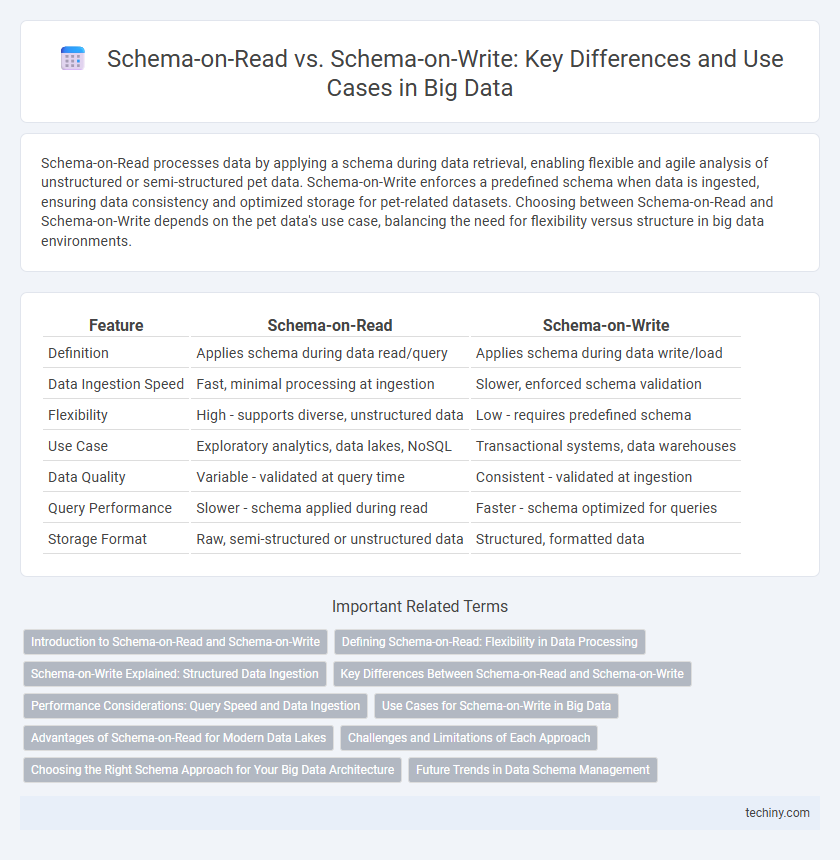Schema-on-Read processes data by applying a schema during data retrieval, enabling flexible and agile analysis of unstructured or semi-structured pet data. Schema-on-Write enforces a predefined schema when data is ingested, ensuring data consistency and optimized storage for pet-related datasets. Choosing between Schema-on-Read and Schema-on-Write depends on the pet data's use case, balancing the need for flexibility versus structure in big data environments.
Table of Comparison
| Feature | Schema-on-Read | Schema-on-Write |
|---|---|---|
| Definition | Applies schema during data read/query | Applies schema during data write/load |
| Data Ingestion Speed | Fast, minimal processing at ingestion | Slower, enforced schema validation |
| Flexibility | High - supports diverse, unstructured data | Low - requires predefined schema |
| Use Case | Exploratory analytics, data lakes, NoSQL | Transactional systems, data warehouses |
| Data Quality | Variable - validated at query time | Consistent - validated at ingestion |
| Query Performance | Slower - schema applied during read | Faster - schema optimized for queries |
| Storage Format | Raw, semi-structured or unstructured data | Structured, formatted data |
Introduction to Schema-on-Read and Schema-on-Write
Schema-on-Write enforces a predefined data structure during the data ingestion process, ensuring data consistency and optimizing query performance in traditional data warehousing. Schema-on-Read defers schema application until data is accessed, providing flexibility to handle diverse and evolving data types commonly found in Big Data environments. This approach supports exploratory analysis by allowing schema adaptation based on the specific use case and query requirements.
Defining Schema-on-Read: Flexibility in Data Processing
Schema-on-Read allows data to be stored in its raw form without predefined structure, enabling flexible and dynamic schema application at the time of data retrieval. This approach supports diverse data types and evolving analytics requirements, making it ideal for big data environments with unstructured or semi-structured datasets. By deferring schema application, organizations can rapidly adapt to changing data sources and query patterns without costly data transformation processes.
Schema-on-Write Explained: Structured Data Ingestion
Schema-on-Write involves defining and enforcing a data schema before data ingestion, ensuring structured data is organized and validated as it enters the storage system. This approach optimizes query performance and data integrity by storing data in a predefined format, commonly used in relational databases and data warehouses. It enables efficient analytics on structured datasets but requires up-front schema design and limits flexibility for unstructured or evolving data sources.
Key Differences Between Schema-on-Read and Schema-on-Write
Schema-on-Read allows data to be stored in its raw form and the schema is applied only when the data is read, enabling flexibility and faster ingestion of varied data types. Schema-on-Write enforces a predefined schema before data is stored, ensuring data quality and consistency but requiring upfront data modeling and slower ingestion. The key difference lies in when the schema is applied: Schema-on-Write is upfront and rigid, while Schema-on-Read is dynamic and adaptable to diverse big data sources.
Performance Considerations: Query Speed and Data Ingestion
Schema-on-Write offers faster query performance by enforcing a predefined structure during data ingestion, optimizing storage for quick retrieval in Big Data environments. Schema-on-Read provides greater flexibility by applying schema at query time, which can slow down query speed but accelerates data ingestion by storing raw data without transformation. Choosing between the two depends on workload requirements: Schema-on-Write suits situations demanding rapid querying, while Schema-on-Read benefits scenarios prioritizing high-volume, diverse data ingestion.
Use Cases for Schema-on-Write in Big Data
Schema-on-Write is ideal for use cases requiring structured, consistent data such as financial reporting, compliance auditing, and enterprise data warehousing where data quality and integrity must be ensured before storage. It enables optimized query performance by enforcing schema validation at write time, making it suitable for operational analytics and business intelligence applications. Industries like banking, healthcare, and retail benefit from Schema-on-Write to maintain accurate transactional records and regulatory compliance in big data environments.
Advantages of Schema-on-Read for Modern Data Lakes
Schema-on-Read offers significant advantages for modern data lakes by enabling flexible data ingestion without the need for upfront schema definition, which accelerates data collection from diverse sources. This approach supports varied and evolving data types, making it ideal for big data analytics and machine learning workflows where schema requirements frequently change. It also enhances agility by allowing schema interpretation at query time, ensuring adaptability to new data formats and reducing data preparation overhead.
Challenges and Limitations of Each Approach
Schema-on-Write requires upfront data modeling, leading to rigidity and difficulties in accommodating evolving data sources or unforeseen queries, which can delay data ingestion and reduce flexibility. Schema-on-Read offers greater agility by deferring schema application until query time, but this approach can result in performance overhead, data inconsistency, and increased complexity in query optimization. Both approaches face challenges in maintaining data quality and governance, with Schema-on-Write emphasizing strict validation and Schema-on-Read risking incomplete or inaccurate insights if schemas are improperly applied.
Choosing the Right Schema Approach for Your Big Data Architecture
Selecting between schema-on-read and schema-on-write depends on the data variety and query patterns within your big data architecture. Schema-on-read offers flexibility by applying schema during data access, ideal for exploratory analysis and unstructured data, while schema-on-write enforces a predefined schema at ingestion, optimizing performance for structured data and predictable queries. Prioritizing your analytical needs and data consistency requirements ensures the right balance between speed, flexibility, and governance in big data management.
Future Trends in Data Schema Management
Schema-on-Read is gaining traction as future data environments demand flexible, agile analytics capable of handling diverse, unstructured datasets without predefining rigid schemas. Advanced AI-driven metadata management and automated schema inference are pivotal trends enhancing schema-on-read scalability and efficiency. Meanwhile, hybrid approaches integrating schema-on-write's data integrity with schema-on-read's flexibility are emerging to optimize performance and adaptability in complex big data ecosystems.
Schema-on-Read vs Schema-on-Write Infographic

 techiny.com
techiny.com